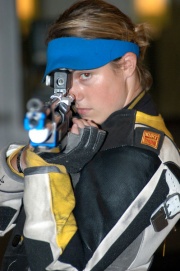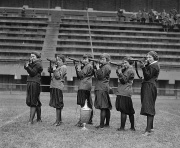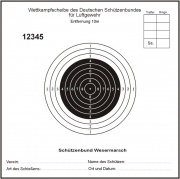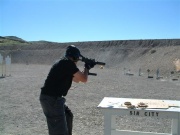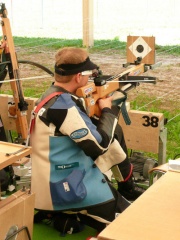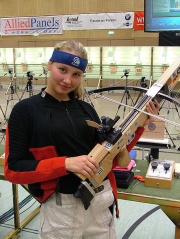Shooting sports
The shooting sports include those competitive sports involving tests of proficiency (accuracy and speed) using various types of guns such as firearms and airguns. Hunting is also a shooting sport, and indeed shooting live pigeons was an Olympic event (albeit only once, in 1900). The shooting sports are categorized by the type of firearm or target used.
Contents |
[edit] History
Concerned over poor marksmanship during the American Civil War, veteran Union officers Col. William C. Church and Gen. George Wingate formed the National Rifle Association in 1871 for the purpose of promoting and encouraging rifle shooting on a "scientific" basis. In 1872, with financial help from New York state, a site on Long Island, the Creed Farm, was purchased for the purpose of building a rifle range. Named Creedmoor, the range opened in 1872, and became the site of the first National Matches until New York politics forced the NRA to move the matches to Sea Girt, New Jersey. The popularity of the National Matches soon forced the event to be moved to its present, much larger location: Camp Perry. In 1903, the U.S. Congress created the National Board for the Promotion of Rifle Practice (NBPRP), an advisory board to the Secretary of the Army, with a nearly identical charter to the NRA. The NBPRP (now known as the Civilian Marksmanship Program) also participates in the National Matches at Camp Perry.
In 1903, the NRA began to establish rifle clubs at all major colleges, universities and military academies. By 1906, youth programs were in full swing with more than 200 boys competing in the National Matches. Today, more than one million youth participate in shooting sports events and affiliated programs through groups such as 4-H, the Boy Scouts of America, the American Legion, U.S. Jaycees, NCAA, the Scholastic Clay Target Program, National Guard Bureau, ROTC and JROTC. These programs have all continued to thrive despite political pressures to disband. The success of these programs is often attributed to an emphasis on safety and education that has resulted in an unprecedented scholastic and collegiate athletic safety record.
French pistol champion and founder of the modern Olympics, Pierre de Coubertin, participated in many of these early competitions. This fact certainly contributed to the inclusion of five shooting events in the 1896 Olympics. Over the years, the events have been changed a number of times in order to keep up with technology and social standards. For example, targets that formerly resembled humans or animals in their shape and size have are now a circular shape in order to avoid associating the sport with any form of violence. At the same time, some events have been dropped and new ones have been added. The 2004 Olympics featured three shooting disciplines (rifle, pistol and shotgun) where athletes competed for 51 medals in 10 men's and 7 women's events -- slightly fewer than the previous Olympic schedule.
The Olympic Games continue to provide the shooting sports with its greatest public relations opportunity. The sport has always enjoyed the distinction of awarding the first medals of the Games. Internationally, the International Shooting Sport Federation (ISSF) has oversight of all Olympic shooting events worldwide, while National Governing Body's (NGB) administer the sport within each country.
Having originally established shooting as an organized sport, the NRA was the obvious choice to administer the United States participation in the Olympic games. The NRA dutifully managed and financially supported international and conventional shooting sports (ie, National Matches) for over 100 years until the formation of USA Shooting.
Because of its long heritage and broad appeal, the shooting sports are enjoyed by a large number of participants around the world. In recent years, however, the shooting sports have become increasingly threatened by social and political reforms. In some countries, voters have declared their disapproval toward the private ownership and possession of handguns. This is generally motivated by the perception that handguns are associated with violent crime instead of sportsmanship. Some governments, such as the British, have enacted restrictive gun control legislation that directly effects the shooting sports.
More recently, a rise in the number of concealed carry permit-holders in the US has led to a surge in interest in various handgun competitions that foster defensive skills, accuracy drills, and personal protection tactics.
[edit] Rifle
- The four Rifle ISSF shooting events (including two Olympic events) consist of long-time target shooting from distances of 10, 50 and 300 m.
- The two Running Target ISSF shooting events consist of rapid shooting at a target that moves sideways from distances of 10 and 50 m.
- Biathlon is an Olympic sport combining shooting and cross-country skiing.
- The CISM Rapid Fire match is a speeded version of the ISSF 300 m Standard Rifle event.
- Muzzle loading and Cowboy action shooting are concerned with shooting replica (or antique) guns.
- Gallery rifle shooting is popular in the UK and was introduced as a substitute for many pistol shooting disciplines following the 1997 handgun ban.
- Benchrest shooting is concerned with shooting small groups with the rifleman sitting on a chair (bench) and the rifle supported from a table. Of all shooting disciplines, this is the most demanding equipment-wise.
- High Power Rifle (also known as "Across the Course" or 'traditional' High power) in the United States is a format that shoots 3-position (standing, kneeling or sitting, and prone) at 200, 300, and 600 yards. The term "Across the Course" is used because the match format requires the competitors to shoot at different distances to complete the course of fire.
- Fullbore target shooting is concerned with shooting at targets at ranges of 300–1200 yards.
- Field Target is an outdoor air gun discipline originating in the United Kingdom, but gaining popularity worldwide.
- There are a vast number of nationally recognized sports, including:
- Full bore and small bore, rifle shooting in the United Kingdom.
- Three position airgun competitions, popular in the United States.
- Field shooting, often at very long distances, popular in Scandinavia.
- Running target shooting at 80 m, on a target depicting an elk, popular in Sweden as a hunting exercise.
- Summer biathlon, with skiing replaced by running, popular in Germany.
- Military Service Rifle is a shooting discipline that involves the use of rifles that are used by military forces and law-enforcement agencies, both past and present use. Ex-military rifles, sniper rifles (both past and present) and civilian versions of current use service rifles are commonly used in the Military Service Rifle shooting competitions. It is popular in the United States and culminates each year with the National Matches being held at Camp Perry, Ohio. Some countries have outlawed civilian shooting at human-silhouette targets, though. Silhouette targets are not used in the National Match Course of Fire. Bullseye targets are used. High Power Rifle competition often is held at the same events as Service Rifle, such as the U.S. national championships each year at Camp Perry. High Power competitors generally are civilians using whatever rifles they prefer within the rules, whereas Service Rifle entrants are limited to current or previous U.S. armed forces weapons. Although according to NRA rules only certain matches allow optical sights, normally those conducted at ranges over 600 yards.
- Palma competition dates from 1876, featuring long-range rifle shooting, out to 1,000 yards. The first Palma match was contested by teams from the U.S. and Ireland (with muzzle loaded rifles at that time), and continues in various nations today.
- One other air rifle event is the 3-position (3P), which consists of the standing, kneeling and prone (lying down) positions.
- Finally, there is a different air rifle class, not yet in the olympics, called the sporter class. This is where you shoot under strict rules, and are not allowed much of the stiff clothing precision shooters use. You can also get sporter 3P events.
[edit] Handgun
- The six Pistol ISSF shooting events (including four Olympic events) consist of both precision and rapid-fire target shooting from distances of 10, 25, and 50 metres. In the UK it is not possible to practice for some of the Olympic events following the Firearms (Amendment) (No. 2) Act 1997.
- Modern pentathlon includes timed shooting with an air pistol as the first of its five parts.
- The CISM Rapid Fire match is similar to the ISSF 25 m Rapid Fire Pistol event.
- Practical shooting, developed by civilian marksmen and later used as a basis for military and police exercises, is a variation where the shooter often moves during shooting, and hit scores and shooting time are equally important.
- PPC 1500, also developed into police exercises, is standard precision shooting, as opposed to practical shooting, but somewhat imitating real-life conditions.
- Muzzle loading and Cowboy Action Shooting, as above, also use revolvers.
- Metallic silhouette shooting, developed to loosely simulate hunting, is shooting at heavy animal-shaped steel silhouettes that must be knocked down to score, typically at long range using very powerful pistols.
- ActionAirgun is an indoor action shooting sport using semi-automatic airsoft pistols and courses of fire downloaded from a central hub. Shooters upload shooting times to a website to resolve competitions.
- Here also there are a vast number of nationally recognized sports, including:
- The National Rifle Association (NRA) Conventional Pistol, shot with up to three different handguns, popular in the United States and Canada and also some other countries. This is sometimes termed Bullseye shooting competition.
- Field shooting, a type of variable rapid-fire competition, popular in Scandinavia.
- The Bianchi Cup One of the most lucrative of all shooting sports championships worldwide
- Other, less formally organized shooting sports include:
- Knocking bowling pins off a table top,
- Steel "reactive" targets,
- and general "plinking" at miscellaneous objects.
[edit] Shotgun
- The three Shotgun ISSF shooting events (presently all Olympic) are based on quick reaction to clay targets thrown by a machine.
- Other shotgun sports with (at least partial) international recognition include Sporting Clays, providing more variation than the standard ISSF events, and Down-The-Line. Five stand is also a shotgun shooting sport similar to skeet, but with more target variety. There are five stations, or stands. At each station there is normally a card that lets the shooter know the sequence of birds he or she will be shooting at.
- Cowboy Action Shooting also may involve shotguns.
- Practical Shooting uses high capacity shotguns (usually pump or semi-automatic). It has emerged particularly in countries where handguns have been banned.
[edit] Action
Action Shooting is a generic term applicable to non-traditional shooting sports, generally characterized by rapid movement within each shooting stage, where most or all begins with holster draw in the case of handguns. Examples include 'practical pistol' as in the International Practical Shooting Confederation (IPSC), the United States Practical Shooting Association (USPSA) and the International Defensive Pistol Association (IDPA), as well as cowboy action shooting, ActionAirgun (AAG), and 'three-gun' events noted below. The latter two involve use of rifles, handguns, and shotguns within the same event.
However, fast AND accurate shooting as opposed to just fast shooting - requiring less physical movement than IPSC, IDPA, and Cowboy Action Shooting, also belongs to the action shooting category owing to the rapidity of firing and mandatory holster draw. Discipline such as National Rifle Association's Action Pistol, also known as The Bianchi Cup, is one example where extreme accuracy fired within tight, predetermined time limits is more paramount than raw speed.
[edit] 3-Gun
3-Gun shooting events (not to be confused with NRA 3-gun "Conventional Pistol" events fired with a rimfire, centerfire and .45 caliber pistol) are practical shooting events where the stages are shot with a combination of a rifle, handgun, and/or shotgun. Although 3-gun competitions take place in most local areas, the largest national annual events are the USPSA 3-Gun Nationals, the MGM Ironman, the Rocky Mountain 3-Gun, the DPMS Tri-Gun Challenge, and the Superstition Mountain Mystery 3-Gun.
[edit] Submachine gun
Submachine Gun competition have been around for over 20 years and are growing in popularity every year.
[edit] Crossbow
Shooting sports aren't just for guns. The International Crossbow-shooting Union (Internationale Armbrustschutzen Union - IAU) was founded in Landshut, Germany on June 24, 1956 as the world governing body for crossbow target shooting. The IAU supervises World, Continental and International crossbow shooting championships in 3 disciplines; 30m Match-crossbow, 10m Match-crossbow and Field-crossbow shooting. IAU World Championships take place every two years with Continental Championships on intervening years. Other International and IAU-Cup events take place annually.
30 metre Match-crossbow shooting is the IAU's premier discipline and championships entry lists regularly include many Olympic-class small bore and air rifle athletes. Shooting takes place on enclosed outdoor ranges which are equipped with electrically driven match-crossbow target transport systems. Existing small bore ranges can be adapted for 30 metre crossbow shooting. In the absence of permanent facilities, shooting can take place on temporary tented ranges using portable target systems.
Athletes shoot from two positions; "Standing" and "Kneeling". Crossbows are loaded using a lever and the Bolt (arrow) is shot at a black and white target card (one shot per card, the same bolt shot repeatedly).
At IAU World and Continental championships national federations can enter teams of three (3) competitors (of either gender) in two Categories; Open Class and U-21 Juniors. And by taking part at IAU Cup matches, a nation can win two (2) additional Quota-Spots thereby increasing to five (5) the number of competitors that the federation concerned can register for the next years World or Continental Match-crossbow championships.
The competition programme consists of 60 shots from 30 meters - 30 shots "Standing" plus 30 shots "Kneeling". The Team competitions (60 shots) take place on the first day of championships. On the following day, the highest scoring competitors in the team events (Open Class and U-21 Juniors) will qualify to take part in the Individual championships. The numbers of competitors to qualify will depend on the number of targets available (usually 28). After 60 shots the top eight (8) competitors in each category will go forward to the Championships Finals (Standing position, 10 shots on voice command). The winners of the Gold, Silver and Bronze Medals are the three competitors with the highest combined scores (60 shot Qualification plus 10 shot Final). If scores are tied after 10 Final shots the competitors concerned continue shot-by-shot until a winner is declared.
10 metre Match-crossbow shooting, which was introduced into the IAU’s programme in 1977, has attracted many new nations to the sport. It’s a highly technical event that’s appreciated by top-flight air rifle athletes and match-crossbow specialists alike. Shooting takes place on indoor ranges equipped with electrically driven Match-crossbow target transport systems. Existing 10 meter airgun ranges can often be adapted, but in the absence of permanent facilities, a temporary shooting range can be set-up in large Sports Hall using portable equipment.Competitors shoot from the Standing position - as in ISSF Air Rifle shooting. Crossbows are loaded using a lever; the Bolt (arrow) is shot at a black and white target card - one shot per card, the same bolt shot repeatedly. The size of the target is the same as the Olympic air-rifle target; 0,5mm diameter 10-ring.
The 10 meter competition programme is run in separate relays for each category; Men shoot 60 bolts, Women and U-21 Juniors each shoot 40 bolts. Team (3 shooters per team) and Individual competitions are run concurrently. The Team results are decide after 60 and 40 bolts respectively. In the Individual events the eight (8) top scoring competitors in each category qualify for Olympic-style 10-shot finals to decide the medal winners.
IAU Championships Timeline - 1958 1st European Match-crossbow Championships Gent Belgium, 1979 1st World Match-crossbow Championships Linz Austria, 1982 1st World Field-crossbow Championships Mikkeli Finland, 1989 1st European Field-crossbow Championships Wolverhampton England, 1992 1st Asian Field-crossbow Championships Tainan Taiwan ROC.
[edit] See also
- Exhibition shooting
- Shooting ranges
- Olympic shooting
- Single Action Mounted Shooting
- Cowboy Action Shooting
[edit] External links
[edit] International governing bodies
- International Shooting Sport Federation
- ESC - European Shooting Confederation
- Muzzle Loaders Associations International Committee
- The International Benchrest Shooters Association
- International Practical Shooting Confederation
- International Defensive Pistol Association
- World Association PPC 1500
- International Handgun Metallic Silhouette Association
- Worldwide Fullbore and High Power Ranges on Google Earth
- Australian Varminting Website
- IAU - International Crossbow-shooting Union
[edit] Other
- NRA Bianchi Cup
- National Target Shooting Association (of Ireland)
- The Paragon School of Sporting
- National Shooting Sports Foundation
- Firearm User Network
- UK Small Bore Rifle Shooting (0.22" Rim Fire and Air Guns)
- UK Clay Pigeon Shooting Association
- National Rifle Association UK
- Airsoft Sports Equipment Reviews
- ActionAirgun
- Collection of targets to print and use in archery and shooting
- United Kingdom Association for Hunter Field Target
- HuntandShoot.org
- Field shooting sports for hunters
- ShootingWiki.org
- ShotgunShoot.com - clay target shotgun sports competitions
- IAPS - International Airsoft Practical Shooting
- Tips and information on precision competition air pistol target shooting
- Conventional (Bullseye) Shooting
- Encyclopedia of Bullseye Shooting
- NRA High Power Rifle Competition information page
